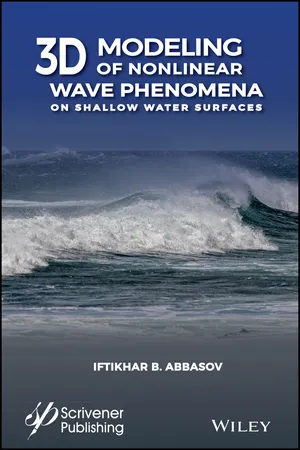
- English
- ePUB (mobile friendly)
- Available on iOS & Android
3D Modeling of Nonlinear Wave Phenomena on Shallow Water Surfaces
About This Book
With climate change, erosion, and human encroachment on coastal environments growing all over the world, it is increasingly important to protect populations and environments close to the sea from storms, tsunamis, and other events that can be not just costly to property but deadly. This book is one step in bringing the science of protection from these events forward, the most in-depth study of its kind ever published.
The analytic and numerical modeling problems of nonlinear wave activities in shallow water are analyzed in this work. Using the author's unique method described herein, the equations of shallow water are solved, and asymmetries that cannot be described by the Stokes theory are solved. Based on analytical expressions, the impacts of dispersion effects to wave profiles transformation are taken into account. The 3D models of the distribution and refraction of nonlinear surface gravity wave at the various coast formations are introduced, as well.
The work covers the problems of numerical simulation of the run-up of nonlinear surface gravity waves in shallow water, transformation of the surface waves for the 1D case, and models for the refraction of numerical modeling of the run-up of nonlinear surface gravity waves at beach approach of various slopes. 2D and 3D modeling of nonlinear surface gravity waves are based on Navier-Stokes equations. In 2D modeling the influence of the bottom of the coastal zone on flooding of the coastal zone during storm surges was investigated. Various stages of the run-up of nonlinear surface gravity waves are introduced and analyzed. The 3D modeling process of the run-up is tested for the coast protection work of the slope type construction.
Useful for students and veteran engineers and scientists alike, this is the only book covering these important issues facing anyone working with coastal models and ocean, coastal, and civil engineering in this area.
Frequently asked questions
Information
Chapter 1
Equations of Hydrodynamics
1.1 Features of the Problems in the Formulation of Mathematical Physics
Table of contents
- Cover
- Title page
- Copyright page
- Preface
- Introduction
- Chapter 1: Equations of Hydrodynamics
- Chapter 2: Modeling of Wave Phenomena on the Shallow Water Surface
- Chapter 3: Modeling of Nonlinear Surface Gravity Waves in Shallow Water
- Chapter 4: Numerical Simulation of Nonlinear Surface Gravity Waves in Shallow Water
- Chapter 5: Two-Dimensional Numerical Simulation of the Run-Up of Nonlinear Surface Gravity Waves
- Chapter 6: Three-Dimensional Numerical Modeling of the Runup of Nonlinear Surface Gravity Waves
- Conclusion
- References
- Index
- End User License Agreement